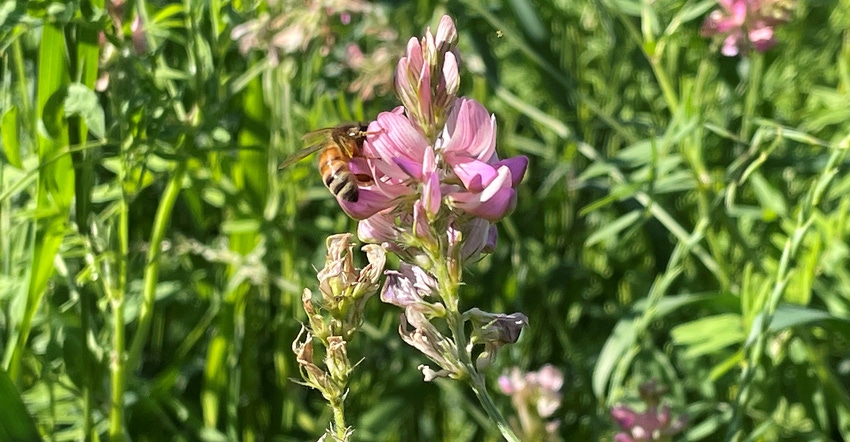
In an ongoing quest to offer healthy hay for horses, a Kasson, Minn., equine feed manufacturer harvested its first crop of “holy hay” in June.
Mary Hartman, founder and owner of Fundamental Feed LLC, contracted with a Pine Island, Minn., hay grower to seed and harvest a small test plot of sainfoin. Also known in some circles as “healthy hay” or “holy hay,” the ancient perennial legume is highly palatable and non-bloating.
“I was researching the equine microbiome [in 2018], and a U.K. research group suggested sainfoin as a food for horses with a variety of health issues,” Hartman says.
A lifelong horse lover, Hartman started researching equine diets after her dressage horse developed health problems. Wary of medication, she started feeding her horse a homemade chia-based product to treat the horse’s stomach ulcers and other maladies. She noticed immediate improvement in her horse’s health and appearance, as well as in other horses that receive the feed supplement.
Hartman received a grant and worked with the Agricultural Utilization Research Institute to do further product research and marketing development. She partnered with a team led by Alan Doering, AURI’s coproducts senior scientist, which provided technical assistance and research at AURI’s Waseca, Minn., pilot lab.

“AURI is a gem in this state,” Hartman says. “I worked with a brilliant team of people led by Alan. They worked with me to create a nutrient-dense horse feed with sainfoin. When I run into snags in production, when I need advice on equipment, or if I need to identify a particular type of professional service to support my efforts, Alan is my first call.”
With AURI’s help, she was able to expand her product line, now known as Stable Feed. Stable Feed is available in five supplements and two equine feed products.
Sourcing sainfoin
Hartman has been contracting with Montana growers for sainfoin since 2019 for her product development and research. This year, a total of 15 acres of sainfoin were seeded in three test plots in Minnesota — a first for her company. Land was tilled and the seed drilled, the same as alfalfa. No weed killer or fertilizer was applied.
The Pine Island plot, which was all sainfoin, yielded 2.25 tons per acre. The second plot, seeded with alfalfa and red clover, also did well. The third plot, planted on a hillside with heavy clay and thick foxtail, did not perform well.
Overall, Hartman was pleased with the first sainfoin harvest. The stand withstood torrential downpours and stood tall during heavy hail. It also smothered weeds, which helped keep the crop clean.
“Herbicides and pesticides are known to kill sensitive bacteria in the equine microbiome, so we are growing this organically and will be amending the soil using regenerative agricultural practices,” she says. “The plants were sap-tested to see what their nutrient profile looked like, with a rating of ‘excellent.’ We will add potash and phosphate to the soil to encourage growth for a second harvest.
Nutritional, environmental benefits
Sainfoin has a similar nutrient value as alfalfa, Hartman says. Its nonbloating properties support horses prone to gas colic, and it has bypass protein for improved protein utilization, high tannins that inhibit parasites and high omega-3s for anti-inflammatory support. Sainfoin hays that Hartman has tested typically have 10% to 14% bypass protein and 12% fiber as fed (24% and 30% as dry matter, respectively).
She also likes the perennial for its environmental benefits. It helps diversify the landscape and takes about a month to flower, providing a longer harvest window. It’s drought-tolerant, fixes nitrogen, sequesters phosphates and supports pollinators.
“I was also extremely interested in sainfoin’s climate-mitigating properties,” she adds. “I employ a lot of young talent, and they are extremely keen to implement strategies and initiatives that provide real multiple levels of ecological benefit. Sainfoin is the first step in that direction.”
Future products
Hartman continues to research possibilities for sainfoin in cattle and sheep markets. She believes it has a place on Minnesota dairy farms. She cited research in Montana and Canada that showed sainfoin in dairy diets mitigates gas production and can increase milk yields by 15% to 30%.
The challenge, however, is finding growers and convincing them to try it. Information available online is outdated, she adds.
To help educate farmers, she is thinking about hosting a webinar in August.
To learn more about Stable Feed and sainfoin, visit stablefeed.com.
About the Author(s)
You May Also Like






